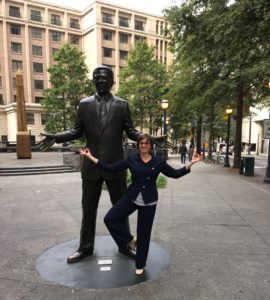5 Blood Curdling Fears and Worst Nightmares of Public Speaking
 All public speakers must face them. Hidden in the conference rooms of haunted hotels, they wait for the right moment to pounce and send chills down our spines, usually right before some big, important presentation. They are the speakers’ blood curdling fears and worst nightmares. Halloween is a perfect time to acknowledge their existence and poke a little fun at them.
All public speakers must face them. Hidden in the conference rooms of haunted hotels, they wait for the right moment to pounce and send chills down our spines, usually right before some big, important presentation. They are the speakers’ blood curdling fears and worst nightmares. Halloween is a perfect time to acknowledge their existence and poke a little fun at them.
1. The Ghost of the Killed Messenger. You know how the saying goes, “Kill the messenger.” And who is the messenger? It’s you, the public speaker. No wonder, the mere task of opening your jaw, moving your mouth, straining your vocal cords in order to produce some incoherent sounds that someone may actually hear is a deadly fear of most people. According to findings of the Chapman University Survey on American Fears, public speaking is the top personal fear in 2016, afflicting 25.9% of Americans. Since early days, the prospect of losing your social standing in a group or being kicked out spelled gloom and doom for humans. The memories of the Ghost of the Killed Messenger took deep roots in the oldest part of our brains, causing doubt and anxiety even in modern-day speakers, whose message may not get them killed, however, it may cause them feel rejected. And that’s like being dead to someone, so it’s a death sentence, however you look at it (or turn away and don’t look). The speech witch told me about a spell that you can use, however, to make the Ghost of the Killed Messenger disappear: “In my message lies the power to connect minds through distance and hour, to shine the light of truth for all, and in that power, I stand tall.” Let me know if the spell works for you.
2. The Memory Maniac. This one is creepy. He picks unsuspecting speakers’ brains. Just when you thought you memorized your presentation, the Memory Maniac would creep into your brain and steal the memory of your speech, leaving no traces. The more panic-stricken you are, the easier it is for the Memory Maniac to do his memory robbery. Wouldn’t you be afraid to forget what you were going to say?
There are a few tricks you can perform, however, to stop the Memory Maniac. First, don’t memorize your presentation word for word. That just leaves too much information in plain view in the brain for the Memory Maniac to steal. Instead, hide it in the Memory Palace. This memory trick originates in the ancient Greece. In his historic overview of the “science of memory,” Carl Malamud tells the story of the poet Simonides of Ceos, who witnessed the destruction of the banquet hall where he sang his poem just minutes before the collapse. Simonides was able to reconstruct the guest list by visualizing the exact location of every guest at the table. This visualization technique became known as the “memory palace.” First, you choose your “memory palace”, which can be any place or route that you remember well. Next, you place your thoughts or images that you want to remember next to distinctive points in the rooms of your palace or along your route. Those points serve as memory hooks. When you need to recall the material, you mentally walk through the palace and “collect” the pieces of information that you left at each distinctive point. Since the memory palace you choose only makes sense to you because you know it well, this trick confuses the Memory Maniac, who wouldn’t know what’s important enough to steal. Another way to escape from the Memory Maniac is to take a nap. Sleep crystallizes all the important details in your memory, and the Memory Maniac can’t carry them away when they are in the crystal form.
3. The Time Thief. This one is sneaky. You successfully used the spell and made the Ghost of the Killed Messenger disappear. You hid all your memories in the memory palace overnight. There is a lot to say. You are half-way through your presentation when you suddenly realize that you have no more time left. The Time Thief used it all up. Have you ever complained about the speakers who went over their allotted time? How about the speakers who kept it short and to the point? Then, you know how important it is to finish on time. A tell-tale sign that the Time Thief is in the room is that the audience members get anxious, stop listening and start looking at their phones. Some may even rush out of the room.
What do you do to keep the Time Thief away from your conference room? First, bring a magic clock. This clock should tell you when to start, when to take breaks, if needed, and when to finish your presentation. Ideally, it should also work as scales to measure all your content and tell your exactly how much time your speech would take. Since those magic clock-scales are hard to come by, try to cut your content a little so that you target about 90% of your allotted time. Don’t overstuff your audience’s brains. They are busy people, not scarecrows. Rehearse the parts of your presentation to know how much each part would take. Monitor the magic clock as you go to know where you should be in your presentation and adjust accordingly. Sprinkle your presentation with some pixie dust activities that can fill up or reduce time as needed. Look for the pixie dust labeled “Q&A” or “Audience Participation.” By the way, you should never end your presentation by throwing pixie dust around. It gives control over your message to whoever happens to catch most of your pixie dust. Plus, it creates a mess in the room. Always tidy up the ending.
4. The Tech Trolls. Plug it in! Speakers love their slides, mikes, WiFi, cameras, projectors and screens until the Tech Trolls shows up and technology stops working. The tech trolls are just grumpy. There is no reason for them to disrupt a well-planned tech-savvy presentation, but they like to do it anyways. It is very scary and frustrating for speakers and event organizers. The only way to defeat the Tech Trolls is to outrun them in the worst-case scenario race. A Tech Troll says, “I will make your video load super slowly.” You say, “I have thought of that and uploaded the whole video to my flash drive so I wouldn’t have to rely on the Internet connection.” Another Tech Troll grumbles, “I will cause a blackout.” You respond, “I have thought of that…I’ve got a few aromatic candles here and a story to tell.” You get the idea. Plan for the worst, and your will outsmart the Tech Trolls.
5. The Audience Zombie Apocalypse. This one is tough. How do you present anything to zombies? The only piece of advice here is you have to know your audience. Take time to learn as much as you can about your audience before your presentation. Ask the event organizers or Siri, search web, connect though social media. Include some content into your presentation that is particularly relevant to your audience that can help you build rapport. And don’t turn into a zombie yourself! Keep it lively!
Happy and safe Halloween!

 As a long-time student of yoga, I have come to appreciate the quiet helper that is there for us in a variety of situations if we care to notice – our own breath. We often take it for granted, but if we learn to pay attention to it and work with it consciously, it can help us regulate stress, boost confidence and increase impact of our speech.
As a long-time student of yoga, I have come to appreciate the quiet helper that is there for us in a variety of situations if we care to notice – our own breath. We often take it for granted, but if we learn to pay attention to it and work with it consciously, it can help us regulate stress, boost confidence and increase impact of our speech.